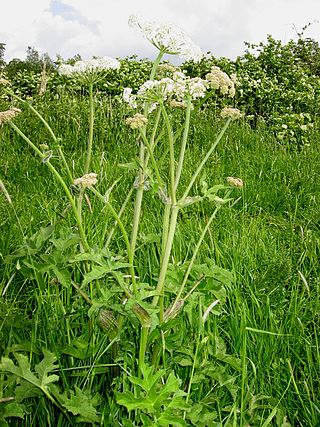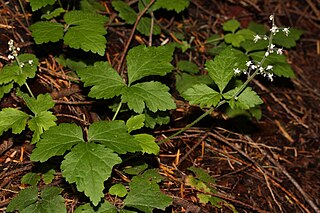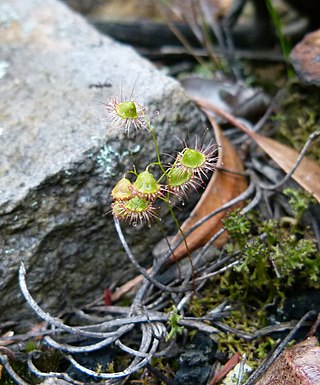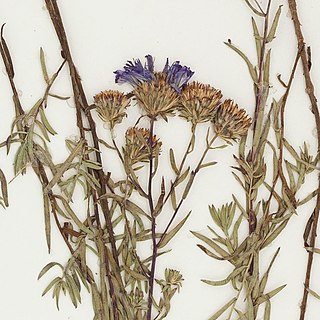
Eriophorum is a genus of flowering plants in the family Cyperaceae, the sedge family. They are found in the cool temperate, alpine, and Arctic regions of the Northern Hemisphere, primarily in the middle latitudes of North America, Europe, and Asia.

Heracleum sphondylium, commonly known as hogweed or common hogweed, is a herbaceous perennial plant in the carrot family Apiaceae, which includes fennel, cow parsley, ground elder and giant hogweed. It is native to most of Europe, western Asia and northern Africa, but is introduced in North America and elsewhere. Other common names include cow parsnip. The flowers provide a great deal of nectar for pollinators.

Tiarella trifoliata, the three-leaf foamflower, is a species of flowering plant in the family Saxifragaceae. The specific name trifoliata means "having three leaflets", a characteristic of two of the three recognized varieties. Also known as the laceflower or sugar-scoop, the species is found in shaded, moist woods in western North America.

Senecio fremontii, the dwarf mountain ragwort, is a species of the family Asteraceae. It takes its scientific name from John C. Frémont.

Drosera stolonifera, sometimes referred to as the leafy sundew, is a tuberous perennial species in the genus Drosera that is endemic to Western Australia. It produces 2 to 3 semi-erect lateral stems that grow 10 to 15 cm long. It is most closely related to D. purpurascens, but differs by several characteristics including height and petiole length. It is native to a number of swampy locations around Perth south to Pinjarra. It grows in peaty water-logged soils in swamp heathland and flowers from September to October. After a bushfire it will flower en masse.

Orbexilum, commonly called leather-root, is a genus of flowering plants in the legume family (Fabaceae). They are native to North America, where they are found in the United States and Mexico, south to Chiapas.

Drosera sect. Erythrorhiza is a section of 14 species of tuberous species in the genus Drosera. It represents a natural group of all the rosetted tuberous Drosera. Most species are endemic to Western Australia, but D. aberrans, D. praefolia, D. schmutzii, and D. whittakeri are also found in eastern Australia.

Drosera andersoniana, the sturdy sundew, is an erect perennial tuberous species in the genus Drosera that is endemic to Western Australia. It produces a basal rosette of leaves similar to that of D. peltata and the stem grows to 8–25 cm (3–10 in). Its pink-white to red flowers emerge from August to September. D. andersoniana grows in loamy soils near granite outcrops.

Drosera graniticola is an erect perennial tuberous species in the carnivorous plant genus Drosera that is endemic to Western Australia. It grows 10–20 cm (4–8 in) high near granite outcrops. White flowers emerge from August to September.

Drosera heterophylla, the swamp rainbow, is an erect perennial tuberous species in the carnivorous plant genus Drosera that is endemic to Western Australia. It grows in shallow water swamps or wet clay flats near granite outcrops and occurs in the vicinity of Perth and to its north. D. heterophylla produces small leaves along an erect stem that can be 10–30 cm (4–12 in) tall. It is the only species in the genus that produces many-petaled flowers. These white flowers emerge from June to September.

Drosera huegelii, the bold sundew, is an erect perennial tuberous species in the carnivorous plant genus Drosera that is endemic to Western Australia. It grows in sandy soils in winter-wet depressions and margins of swamps and occurs along the south-west coast of Australia. D. huegelii produces small, bell-shaped leaves along an erect stem that can be 10–50 cm (4–20 in) tall. White to cream-coloured flowers emerge from June to September.
Drosera intricata is a scrambling or climbing perennial tuberous species in the carnivorous plant genus Drosera that is endemic to Western Australia. It grows in clay-sand soils on swamp margins, or other habitats that are seasonally wet. D. intricata produces small carnivorous leaves along a glabrous stem that can be 25–40 cm (10–16 in) tall. Its 3-12 yellow flowers emerge from September to October. It gains its species name, intricata, from its twining or winding habit.
Jalantzia is a genus of flowering plants in the aster tribe Astereae within the sunflower family Asteraceae. It was previously known as VernoniopsisHumbert, an illegitimate name. Its species are native to Madagascar.

Salvia canescens, the hoary sage, is a herbaceous perennial that is endemic to the Caucasus Mountains. The specific epithet, canescens, refers to the off-white hairs covering the leaves.

Drosera subg. Lasiocephala, sometimes collectively known as the petiolaris-complex, is a subgenus of 14 species in the genus Drosera. These species are distinguished by their subpeltate to peltate lamina.

Drosera trinervia is a species in the carnivorous plant genus Drosera that is endemic to the Cape Provinces of South Africa. It was first described by Kurt Polycarp Joachim Sprengel in his 1820 work Neue Entdeckungen im ganzen Umfang der Pflanzenkunde.
Drosera villosa is a species of sundew native to south-east Brazil. It was originally described by Augustin Saint-Hilaire in 1826.

Symphyotrichum turneri is a species of flowering plant in the family Asteraceae native to Durango, Mexico.
Drosera amazonica is a species of sundew native to northern Brazil. It was first described by Fernando Rivadavia, Andreas Fleischmann and Maria Vicent in 2009.
Drosera androsacea is a species of sundew native to western Australia. It was first described by Ludwig Diels in 1904.














